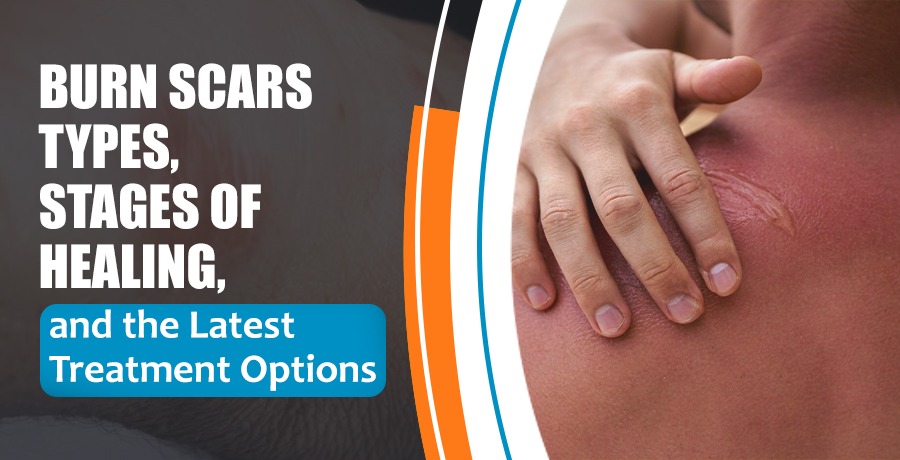
Burns are some of the most common injuries you can get in the home. Whether due to a small mishap with a hot pan, a splash of boiling water, or an unwelcome lesson about sun protection after a day outdoors, we have all experienced a burn at some point. While we usually just focus on what immediate care to take, as well as how to relieve pain often resulting in a frantic search for the 'best sunburn treatment' or first aid procedure, we often reserve thought about long-term ramifications, such as scarring.
Burn scars can be a permanent reminder of a physical injury, which can limit the function of the skin, and can affect confidence levels as well as appearance.
Fortunately, if you know about the type of burn, what stages of healing take place, and the current advancements in dermatological care, you would be surprised at the difference treatment can make. This will be a complete guide about everything you need to know regarding burn scars and what the best up-to-date treatments to minimize them are.
Not All Scars Are Equal: Understanding the Types of Burn Scars
The journey of a scar begins with the severity of the initial burn. Burns are generally classified by degrees:
- First-Degree Burns - Affect only the outer layer (epidermis). They cause redness and pain (like a mild sunburn), but will usually heal within a week and do not scar.
- Second-Degree Burns - Affect both the epidermis and underneath layer (dermis), usually causing blistering, pain and redness. These cause moderate to severe pain, and can take weeks to heal. Second-degree burns can easily scar.
- Third-Degree Burns - the most severe degree. Destroy the top two layers of skin and may destroy underlying tissue, bones, and nerves. Redness and blistering may never occur as the skin may be white, black, and/or charred. Burning causes damage to all layers of skin and deeper. Medical treatment is needed, and the burns will always scar.
The scars that form from second and third-degree burns have distinct characteristics:
1. Hypertrophic Scars: The most common type of burn scar. They are red or purplish, raised above the normal skin, and can be warm or itchy. Hypertrophic scars are associated with the body laying down too much collagen, but the scar will remain within the area of the original burn.
2. Keloid Scars: Keloid scars are also similar to hypertrophic scars in that they are both raised and itchy; the most major factor that separates the two is that keloids grow outward aggressively from the original injury site and form shiny hairless bumps that are often rounded. There is a strong hereditary link to keloid formation.
3. Contracture Scars: Contracture scars are ones that can be significantly problematic and are common with most severe burns that cover a joint. As the scar tissue matures, the contracture scar will shrink and tighten—all the goodness of a t-shirt that shrinks in a hot dryer. The contracture of skin, muscles, and tendons can limit the range of motion by restricting movement. This is a specific concern after a major burn.
The Healing Journey: Three Stages of Scar Formation
A scar doesn’t just appear overnight. It develops over a long and complex process. Understanding these stages can help you know what to expect.
- Stage 1: The Inflammatory Phase (First 1-2 Weeks): This is the body’s emergency response. The area will be red, swollen, and painful as the body works to clean the wound and prevent infection. Proper wound care is critical here. A doctor might recommend a specific burn ointment or dressing to keep the area clean, moist, and protected.
- Stage 2: The Proliferative Phase (Weeks to Months): This is the rebuilding phase. The body goes into overdrive producing collagen to close the wound. This rapid production is what sets the stage for a raised hypertrophic or keloid scar. The scar will often appear very red and start to thicken during this period.
- Stage 3: The Maturation Phase (Up to 2 Years): This is the final remodeling stage. The body slowly begins to break down the excess collagen and reorganize the tissue. During this long phase, the scar will gradually soften, flatten, and fade in color. Patience is key, as the final appearance of a scar isn't truly known until this stage is complete.
Modern Hope: The Latest Treatment Options for Burn Scars
While some fading happens naturally, many people seek treatments to speed up the process and improve the final outcome. Fortunately, there is a wide array of options available, from at-home care to advanced clinical procedures.
Initial & At-Home Management
- Silicone Gels and Sheets: Considered a gold-standard, non-invasive treatment, applying silicone to a healed burn can hydrate the scar tissue, reduce collagen overproduction, and help flatten raised scars while reducing redness and itchiness.
- Pressure Garments: For larger or more severe burns, custom-fitted pressure garments are often prescribed. Worn for several months, they apply constant, gentle pressure to the scar, which helps to control collagen growth and prevent hypertrophic and contracture scars.
- Sun Protection: This cannot be overstated. New scars are extremely vulnerable to UV radiation, which can cause them to darken and become much more noticeable. Protect the scar with clothing or a broad-spectrum sunscreen of SPF 30 or higher.
Professional Skin Treatment
When at-home care isn't enough, it’s time to consult a specialist. Modern dermatology offers powerful tools to revise and reduce burn scars.
- Scar Laser Removal: This is a highly effective and popular skin treatment . Different types of lasers are used to target specific problems.
- Pulsed-Dye Lasers (PDL) excel at reducing the redness and pinkness of scars by targeting the small blood vessels within them.
- Fractional Ablative Lasers (CO2 or Erbium) work by creating microscopic columns of heat in the scar. This breaks down the thick, disorganized scar tissue and stimulates the body to create new, smoother, and more organized collagen, improving both texture and flexibility.
- Steroid Injections: Corticosteroid injections directly into hypertrophic or keloid scars can help break down the excess collagen, significantly reducing their size, firmness, and associated itchiness.
- Microneedling: This procedure uses fine needles to create controlled micro-injuries in the scar, triggering a natural healing response that can soften the scar and improve its texture and color.
Surgical Intervention
For the most severe cases, particularly contracture scars that limit movement, surgery may be the best option. A plastic surgeon can perform procedures like scar release surgery (Z-plasty) to restore flexibility or skin grafting to replace the tight scar tissue.
Your Path Forward
Living with a burn scar can be challenging, but you are not without options. The journey from injury to a faded, manageable scar is a marathon, not a sprint. By understanding the type of scar you have and working with a dermatologist or plastic surgeon, you can create a personalized skin treatment plan that utilizes the best of modern medicine. While complete removal is rarely possible, a dramatic improvement in appearance and function is more achievable today than ever before.

